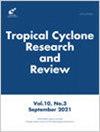Analysing the atmospheric-oceanic conditions driving the sustained long track and intensity of Tropical Cyclone Freddy
IF 4.1
4区 地球科学
Q3 METEOROLOGY & ATMOSPHERIC SCIENCES
引用次数: 0
Abstract
During February–March 2023, the record-breaking tropical cyclone (TC) Freddy caused widespread flooding and damages across southeastern Africa. While <5 % of TCs make landfall into southern Africa, TC Freddy made landfall twice and is the only TC in the past two decades that has tracked over 8000 km across the entire southern Indian Ocean. To understand why TC Freddy was so unique, this study investigated the evolution, track and atmospheric-oceanic mechanisms driving TC Freddy using the ERA5, CFSv2, OSTIA, NCEP-NCAR datasets and track data from various sources. It was found that SSTs were >27 °C during TC Freddy’s lifetime, while TC Dingani and a split Mascarene High played a role in steering TC Freddy across the southern Indian Ocean. Leading up to the development of TC Freddy, conditions were favourable for TC genesis, as indicated by the levels of the Genesis Potential Parameter (GPP) and its modified version (GPPI), the tropical cyclone heat potential levels, and elevated SSTs. Ridging subtropical anticyclones and the Mascarene High alongside favourable steering flow and GPP (and GPPI) conditions resulted in Freddy’s double landfall in Mozambique. In assessing the tracks, it was found that there are discrepancies in the track of the commonly used IBTrACS when compared to ERA5 and RSMC tracks, which has implications for impact studies due to the underestimation of landfall considerations. This study reveals the unique characteristics and atmospheric-oceanic mechanisms driving TC Freddy, emphasising the importance of accurate representation of favourable conditions and track data for enhancing TC forecasting and impact assessments.
分析驱动热带气旋弗雷迪持续长路径和强度的大气-海洋条件
2023年2月至3月期间,破纪录的热带气旋“弗雷迪”在非洲东南部造成了广泛的洪水和破坏。虽然5%的热带风暴在非洲南部登陆,但热带风暴弗雷迪却两次登陆,是过去20年里唯一一个在整个南印度洋范围内追踪超过8000公里的热带风暴。为了理解为什么“弗雷迪”如此独特,本研究利用ERA5、CFSv2、OSTIA、NCEP-NCAR数据集和各种来源的跟踪数据,研究了“弗雷迪”的演变、轨迹和驱动“弗雷迪”的大气-海洋机制。发现TC弗雷迪一生中海温为27°C,而TC Dingani和分裂的Mascarene High在引导TC弗雷迪穿越南印度洋方面发挥了作用。热带气旋“弗雷迪”发展前,其形成势参数(GPP)及其修正值(GPPI)水平、热带气旋热势水平和海温升高都表明了热带气旋形成的有利条件。脊状副热带反气旋和马斯喀林高压以及有利的转向气流和GPP(和GPPI)条件导致弗雷迪在莫桑比克两次登陆。在评估路径时,我们发现常用的IBTrACS路径与ERA5和RSMC路径存在差异,由于低估了登陆因素,这对影响研究产生了影响。本研究揭示了热带气旋“弗雷迪”的独特特征和驱动机制,强调了准确表征有利条件和轨迹数据对加强热带气旋预报和影响评估的重要性。
本文章由计算机程序翻译,如有差异,请以英文原文为准。
求助全文
约1分钟内获得全文
求助全文
来源期刊

Tropical Cyclone Research and Review
METEOROLOGY & ATMOSPHERIC SCIENCES-
CiteScore
4.60
自引率
3.40%
发文量
184
审稿时长
30 weeks
期刊介绍:
Tropical Cyclone Research and Review is an international journal focusing on tropical cyclone monitoring, forecasting, and research as well as associated hydrological effects and disaster risk reduction. This journal is edited and published by the ESCAP/WMO Typhoon Committee (TC) and the Shanghai Typhoon Institute of the China Meteorology Administration (STI/CMA). Contributions from all tropical cyclone basins are welcome.
Scope of the journal includes:
• Reviews of tropical cyclones exhibiting unusual characteristics or behavior or resulting in disastrous impacts on Typhoon Committee Members and other regional WMO bodies
• Advances in applied and basic tropical cyclone research or technology to improve tropical cyclone forecasts and warnings
• Basic theoretical studies of tropical cyclones
• Event reports, compelling images, and topic review reports of tropical cyclones
• Impacts, risk assessments, and risk management techniques related to tropical cyclones
 求助内容:
求助内容: 应助结果提醒方式:
应助结果提醒方式:


